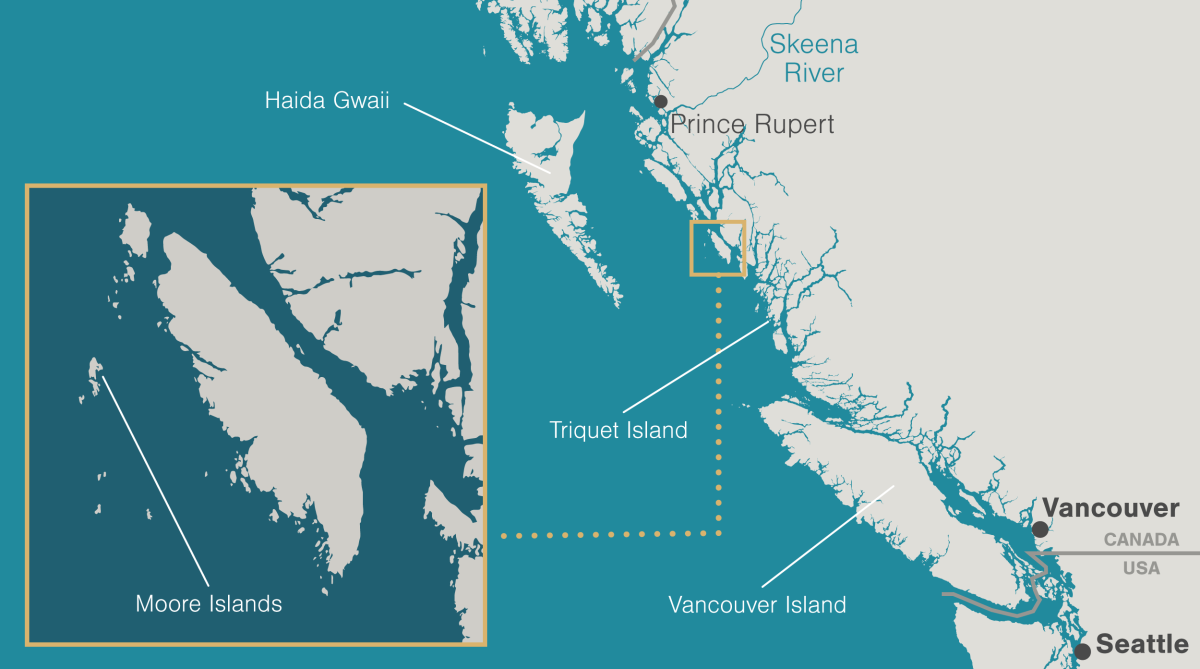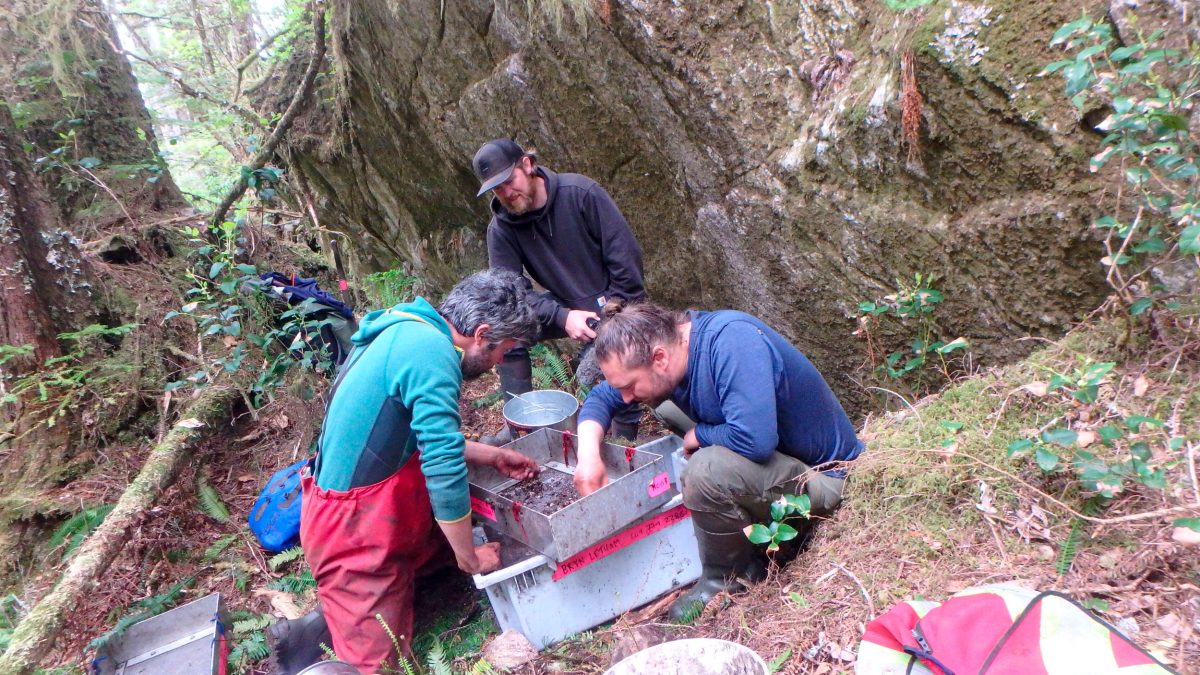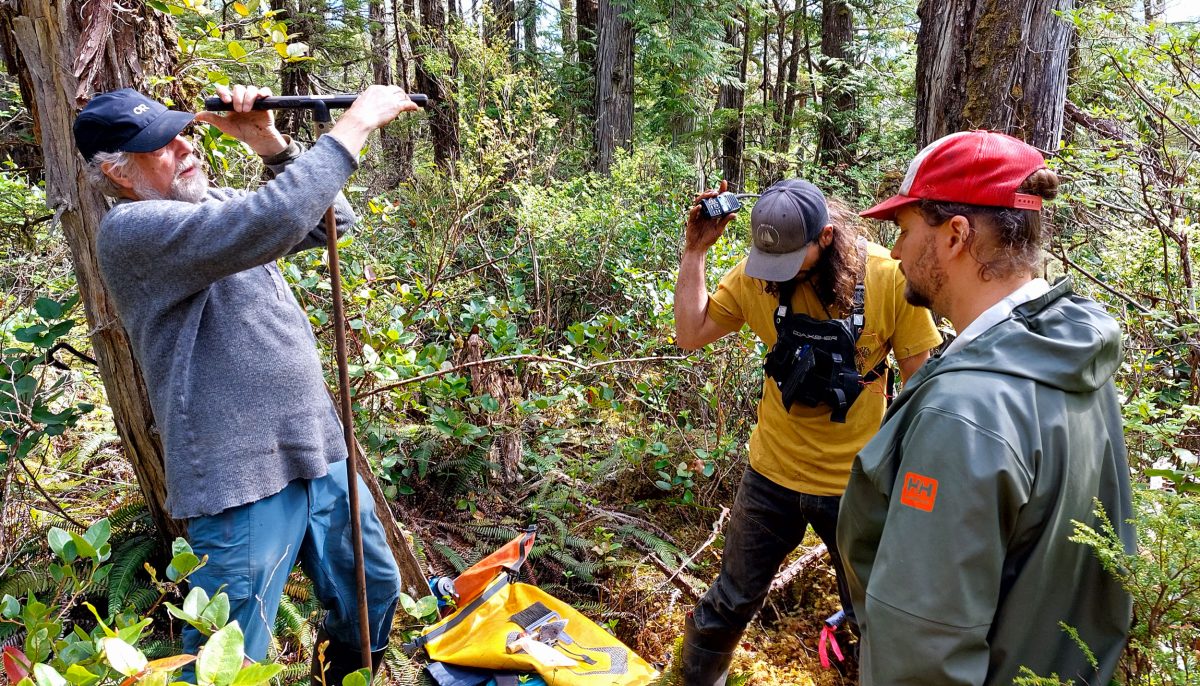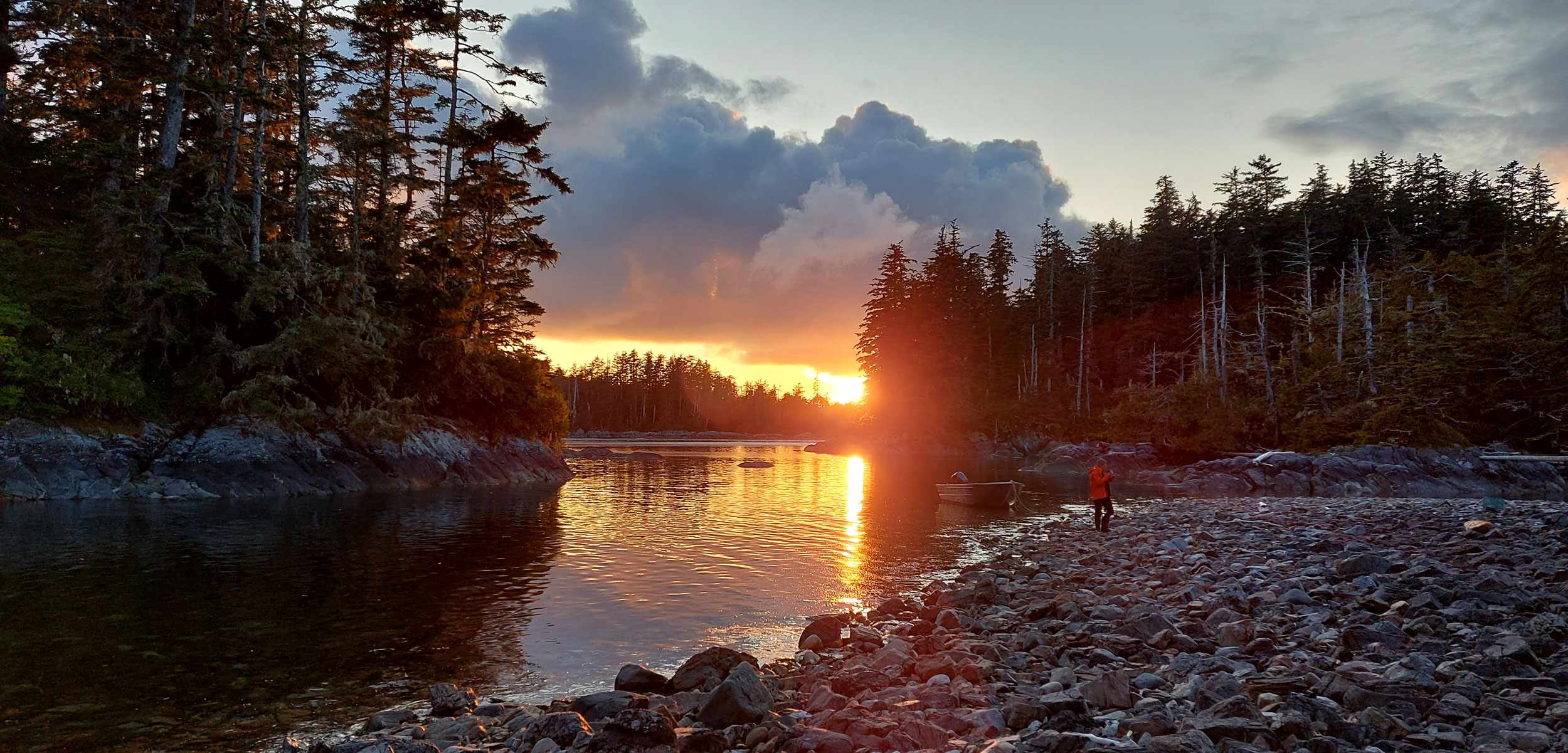Of Gitnuganaks, Glaciers, and Life at the End of the Last Ice Age
Off the British Columbia coast, scientists guided by Indigenous knowledge are unearthing evidence of island life long, long ago.
Article body copy
The Gitnuganaks came from the sea.
Around the time of a great flood, when the world was still sparsely populated, Chief Dzagamsagisk and his crew were resting at sea in their anchored canoe off what is now northwest British Columbia when a splashing fish woke them up. The crew scolded the fish and, as punishment, damaged its fins before returning to their slumber.
When they awoke again, the chief and his men realized they’d been brought down to the underwater home of the mighty spirit Gitnuganaks. The spirit was angered by how they’d treated the fish and made the men promise to respect the ocean and its inhabitants. The crew assented and, satisfied with their vow, Gitnuganaks blessed them with many gifts, including the assurance that they would always have good luck while hunting.
When the crew finally returned home, they discovered a year had passed. Chief Dzagamsagisk chose that his lineage would take on the name Gitnuganaks. And, as the spirit promised, he was indeed successful whenever he hunted. That is until one day when the chief went out with a new crew. These hunters killed a fish they didn’t intend to eat and, with a splash, a whirlpool swallowed their canoe. While the other men drowned, Chief Dzagamsagisk went to live with the spirit.
Thousands of years later, this oral history—the origin of the Gitnuganaks lineage—is helping guide Spencer Greening (La’goot) and his colleagues toward what may be one of the oldest archaeological sites on the northwest coast of North America.
For the past several summers, Greening, a young Gitga’at anthropologist and a doctoral candidate at Simon Fraser University in British Columbia, has been working with a small, mostly Gitga’at crew to excavate the Moore Islands. This archipelago, off northwest British Columbia, is the origin place of the Gitnuganaks, a lineage whose members now live within several Ts’mysen (Tsimshian) nations, including the Gitga’at, Kitasoo/Xai’xais, and Gitxaała.

The Moore Islands archipelago (see inset) is made up of three main islands and multiple islets about 80 kilometers off British Columbia’s northern coast. The Gitnuganaks lineage has its origins in the Moore Islands. Most Ts’mysen lineages, of which the Gitnuganaks are a part, trace their origins to the mainland along what is now called the Skeena River. Map data by ArcGIS
For millennia, the Moore Islands, known to local First Nations as Laxnuganaks or ’Ngwünaks, were home to Indigenous peoples who harvested, hunted, and thrived on the land and the surrounding sea. The archipelago continues to hold great importance for many Ts’mysen nations, Greening explains. Today, the Moore Islands are largely unoccupied, though they are used and stewarded by members of the Gitga’at and Kitasoo/Xai’xais Nations who visit for seasonal harvesting and monitoring. Some of the islands are also part of a provincial seabird ecological reserve.
But while the villages and old harvesting sites are long buried, Greening says oral history preserves stories of life on these islands. It’s these stories that first brought Greening and his colleague Bryn Letham, an archaeologist at Coast Mountain College in northern British Columbia, to the archipelago.
Details from the account of Chief Dzagamsagisk and the mighty spirit—including the suggestion of a sparse population—signaled to the researchers that the Gitnuganaks’ origin story may hearken back to a time soon after the end of the last ice age. And for two scientists searching for an archaeological site that might yield information about some of the region’s earliest inhabitants, the Moore Islands looked perfect.
Geographical data supports their search. The vast Cordilleran ice sheet, which once stretched from southern Alaska to Washington State, melted from the outside in, Letham explains. So while most of North America remained in the icy grip of the last glacial period, the Moore Islands were ice-free and hospitable by at least 16,000 years ago, he says.
Further supporting their decision to hone in on the Moore Islands is how all this ice contorted the area’s tectonic plates, turning the region into something of a seesaw. During the last glacial period, heavy ice sitting on the mainland pushed the land down, causing the sea level there to rise. Meanwhile, many outer islands went for a ride: they were uplifted and saw local sea levels drop.
Resting somewhere in the middle, right about where the seesaw’s fulcrum would be, are the Moore Islands. Here, modern sea levels are roughly the same as they were during the last ice age. This, Letham says, means that early archaeological sites on the islands should be fairly accessible and easy to locate, rather than deep underwater or at the tops of mountains as they are in some other parts of the coast that have seen more substantial change over millennia.
Daryl Fedje, an archaeologist with the University of Victoria and the Hakai Institute, explains how ice has transformed the coast—and why the area off northwestern British Columbia is such a prime location to look. Video by the Hakai Institute
So in 2019, with support from the Gitga’at and Kitasoo/Xai’xais Nations and guidance from elders who remember harvesting everything from seaweed to seagull eggs in the archipelago, the crew set out for the Moore Islands.
By reconstructing the historical sea level and environmental conditions, the scientists predicted where people would have landed canoes, settled, and harvested on the islands long ago. Over the past five years, Greening, Letham, and their colleagues have conducted four summertime excavations. During each visit, they spent two weeks crouched on beaches and in rock shelters, scraping through millennia of hearths, meals, and debris left by people making stone tools. These are convincing signs of human occupation long ago—signs that Greening hopes will help push the boundary of Western scientists’ understanding of how long Indigenous peoples have been on the coast.

For Spencer Greening (La’goot), working on the Moore Islands is particularly meaningful. Though Greening, right, is not a member of the Gitnuganaks lineage, his great-great uncle was the last person born on the Moore Islands in the early 1900s. As Greening excavates, harvests, and spends time on the lands, he’s always looking for ways to continue stewarding the environment as the Gitnuganaks learned to. Photo by Bryn Letham
Already, the team—with guidance from Gitga’at elders—has located a 4,000-year-old village. At other sites, they’ve unearthed stone tools that appear to be between 11,500 and 15,000 years old and a 7,500-year-old obsidian microblade from Anahim Peak, a volcano about 300 kilometers away in central British Columbia.
“We’re looking at thousands and thousands of years of occupancy,” Greening says.
At various sites, including the 4,000-year-old village and several smaller camps and villages, the researchers have also found the remains of seabirds, fish, and mammals, including dogs, and even a cluster of 8,000-year-old butchered whale ribs and vertebrae. These cetacean relics are particularly exciting as Ts’mysen people aren’t known to be whalers. Letham says it’s not clear whether the whale was hunted or scavenged, but its presence provides a snapshot of a specific moment in time.
Based on the artifacts they’ve already found and the sizes of the villages—the largest of which Letham says could have housed more than 100 people—it’s clear the Moore Islands were used consistently by large groups for at least 11,000 years. But Letham feels this estimate is conservative. He believes further fieldwork and analysis will push that date way back.
Finding the oldest site on North America’s northwest coast—early evidence of post-glacial human occupation—is the goal for many archaeologists working in the region. Currently, Letham explains, the oldest confirmed sites in the area are between 13,500 and 14,000 years old, and the oldest artifacts are stone tools recovered from Triquet Island farther south.
Letham says there’s tantalizing evidence that people may have been inhabiting the Moore Islands around the end of the last ice age. For instance, in 2023, Greening found a stone worked by human hands pressed into a layer of glacial clay, suggesting that people and glaciers coexisted. This artifact has yet to be fully analyzed, but the glacial clay is about 15,500 years old. The scientists’ previous field seasons also revealed wood and mussel shells that were dated to about the same age, suggesting that the islands would have been hospitable enough for people to have made a go of living there.
While confirming an early occupation date would be a welcome addition to an already exciting project, Letham says what’s driving their search is a desire to pair the impressive archaeological record with oral history to reveal how people lived on these tiny islands at the edge of the continent—no matter how long ago that was.

The purpose of the Moore Islands project is not only to prove that oral histories are accurate, says Greening, right, but to use archaeology and oral history together to paint a picture of the past. As Indigenous people, he says, “We know who we are and where we come from.” Photo by Bryn Letham
To Pedro Monarrez, a paleobiologist at the University of California, Los Angeles, who was not involved in the excavations, the Moore Islands project plays a significant role in highlighting and preserving knowledge held by some of North America’s first residents—people who learned to live with and care for the land for thousands of years. Monarrez says there’s immense value in revitalizing this knowledge, both for scientists looking to understand the past, and for all of us as inhabitants of a changing planet.
Vernon Brown, a member of the Gitnuganaks lineage and an incoming Kitasoo hereditary chief who will soon adopt the name Chief Dzagamsagisk, is grateful for the work being done to unlock the history of his people and push back the scientifically validated dates of occupation. The work underway on the Moore Islands “shows the importance of ancient stories that are thousands of years old,” says Brown, who didn’t take part in the excavations but collaborated with the crew. “As a First Nations person, that starts to paint an amazing picture of my identity.”
Brown says there’s a lot for Gitnuganaks people to relearn and connect with. Beyond that, “I think it’s so important that everybody starts to learn our stories and even take an interest in other nations’ stories,” he says, “because it’s a really cool part of our history.”
In 2024, Letham and the rest of the crew plan to return to the Moore Islands. With more days digging thousands of years into the islands’ history, their work should provide new glimpses of the world at the end of the last ice age, and of the lives of the people who come from the sea.

